Cannabis has become a global phenomenon, celebrated not only for its recreational use but also for its therapeutic properties. Whether you’re a curious enthusiast, a home grower, or someone looking to learn more about the plant’s structure, understanding cannabis plant anatomy is key to unlocking the secrets of its growth, potency, and versatility.
In this article, we’ll dive deep into the anatomy of the cannabis plant, from its root system all the way to its leaves, stems, and flowers. You’ll learn how each part contributes to the plant’s health, yield, and medicinal qualities.
By the end, you’ll have a better appreciation for how this fascinating plant grows and how its unique anatomy plays a role in cannabis cultivation and consumption.
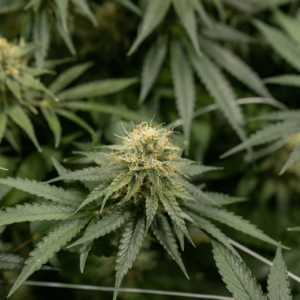
Why Understanding Cannabis Plant Anatomy Matters
The anatomy of the cannabis plant is often overlooked, but it’s a crucial aspect for both growers and consumers alike. Whether you’re trying to grow the perfect cannabis plant, making sure your flowers are rich in cannabinoids, or simply curious about how this plant thrives, understanding its structure is the first step.
Knowing how each part of the cannabis plant works can help you understand the entire cultivation process, from germination to harvest. It also gives insight into the plant’s medicinal properties—after all, the higher the quality of the plant, the higher the quality of the products you get from it.
In this guide, we will explore each part of the cannabis plant in detail to give you the knowledge you need to better appreciate and care for this amazing plant.
The Cannabis Plant: Overview and Classification
Before we dive into the specifics of cannabis anatomy, it’s important to have a basic understanding of the cannabis plant itself. Cannabis is a flowering plant that belongs to the Cannabaceae family and has been cultivated for thousands of years for various uses, including medicinal, recreational, and industrial purposes.
Cannabis plants are classified into three main species:
- Cannabis sativa: Known for its tall, slender appearance, and uplifting effects, often used for hemp production and recreational use.
- Cannabis indica: Characterized by shorter, bushier plants, commonly associated with relaxing and sedative effects.
- Cannabis ruderalis: A lesser-known species that is typically used in hybrid breeding due to its ability to flower without relying on light cycles (autoflowering).
Most cannabis plants grown today are hybrids, often combining indica and sativa genetics. Understanding the species and their characteristics can help growers determine what plant anatomy they’re working with and how to optimize growth conditions.
The Root System: The Foundation of the Cannabis Plant
The cannabis root system is often underappreciated but plays a vital role in the plant’s growth and health. Roots are responsible for anchoring the plant in the soil and absorbing water and nutrients. Without a healthy root system, the cannabis plant would struggle to thrive.
Taproot and Lateral Roots
At the core of the cannabis plant’s root system is the taproot. This is the main, thick root that grows vertically downwards into the soil. It serves as the plant’s primary anchor and can grow quite deep. Surrounding the taproot are lateral roots, which spread horizontally to absorb more nutrients and water. These roots form a dense network that supports the plant’s growth.
- Taproot: Acts as the central anchor, securing the plant in place.
- Lateral roots: Spread outward and absorb water and nutrients to support healthy plant development.
The Role of Roots in Cannabis Growth
Roots are responsible for drawing up water and essential minerals from the soil, which are then transported through the plant’s stem and leaves. This nutrient flow is essential for all plant functions, including photosynthesis, flower development, and overall vitality. Healthy roots result in a more resilient plant capable of producing higher yields.
Root Health Tips for Growers:
- Proper Drainage: Good drainage helps prevent root rot.
- Avoid Overwatering: Excess moisture can drown the roots, leading to mold and other diseases.
- Use Root Stimulators: These can encourage stronger root development in the early stages.
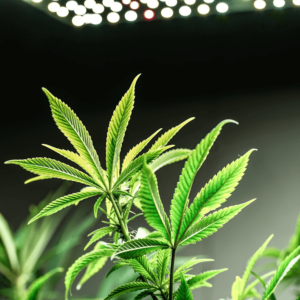
The Stem: The Backbone of the Cannabis Plant
The stem of the cannabis plant is its structural backbone. It supports the leaves, flowers, and branches, and it also plays a critical role in transporting nutrients and water through the plant’s vascular system. The stem connects the roots to the leaves and flowers, acting as a highway for essential resources.
Primary and Secondary Growth
Cannabis stems go through two main growth phases:
- Primary Growth: This is the initial growth of the main stem, which increases in height and width.
- Secondary Growth: As the plant matures, secondary branches develop from the main stem, increasing the plant’s overall canopy.
The stem is made up of two primary vascular tissues: xylem and phloem. The xylem carries water and nutrients from the roots, while the phloem transports sugars and other products of photosynthesis from the leaves to the rest of the plant.
Stem Health and Plant Growth
The stem’s thickness and strength are crucial for supporting the plant’s weight, especially as it matures and produces heavy buds. A thick, strong stem indicates a healthy, well-developed plant capable of supporting large flowers. In contrast, a weak or brittle stem can lead to bending, breakage, or other growth issues.
Tips for Maintaining Healthy Stems:
- Provide Adequate Lighting: Good light intensity encourages strong stem growth.
- Support Branches: In flowering, branches may need support to prevent snapping under the weight of dense buds.
- Pruning: Regular pruning and topping (removing the top of the main stem) help improve stem strength and promote lateral growth.
Leaves: The Photosynthesis Powerhouse
Cannabis leaves are crucial for photosynthesis—the process through which the plant converts light into energy. A healthy leaf system is essential for growth and producing cannabinoids like THC and CBD.
Leaf Structure
Each cannabis leaf consists of several key parts:
- Leaflets: The individual segments that make up the leaf blade.
- Petiole: The stalk that connects the leaf to the main stem.
- Veins: The vascular tissue in leaves that transports water and nutrients.
The fan leaves, the large, broad leaves at the top of the plant, are the main site of photosynthesis. Smaller sugar leaves, found near the buds, are still important but are less involved in photosynthesis.
Leaf Function
Leaves absorb sunlight and convert it into energy through photosynthesis, which provides fuel for the plant’s growth. Additionally, the stomata on the leaves facilitate the intake of carbon dioxide and the release of oxygen. The leaves also help regulate water loss through transpiration.
Leaf Health Tips for Growers:
- Ensure Proper Light: Make sure your plants get the right amount of light to promote healthy leaf growth.
- Nutrient Balance: Yellowing leaves could indicate nutrient deficiencies.
- Defoliate Strategically: Removing lower leaves that don’t receive much light helps redirect energy to the upper, more productive parts of the plant.
Flowers: The Reproductive Organs of the Cannabis Plant
Cannabis flowers are the plant’s reproductive organs and are where the magic happens. It’s in the flowers that the plant produces its most valuable compounds: cannabinoids and terpenes.
Flowers are crucial for both medicinal and recreational cannabis consumers, as they are the source of buds.
Male vs. Female Flowers
Cannabis plants are dioecious, meaning they have separate male and female plants. Female plants are the ones that produce the buds, while the male marijuana plant produces pollen. Female flowers are more desirable for cultivation, as they produce resin-rich buds that contain high concentrations of cannabinoids.
- Female Flowers: These have small pistils (hair-like structures) and eventually develop into buds.
- Male Flowers: Male plants produce pollen sacs that fertilizes the female plants but are usually removed in commercial cultivation to prevent seed production.
Marijuana Plant Anatomy of Female Cannabis Flowers
The female cannabis flower consists of the calyx, pistils, and trichomes:
- Calyx: The protective outer layer of the flower.
- Pistils: Hair-like structures that help catch pollen and play a role in flower fertilization.
- Trichomes: Tiny, glandular structures that produce cannabinoids and terpenes, giving cannabis its aroma and effects.
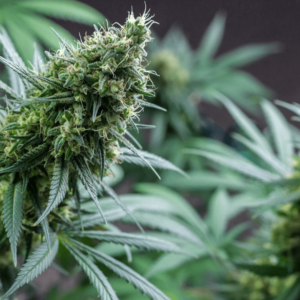
Trichomes: The Tiny but Mighty Cannabinoid Factories
Trichomes are perhaps the most interesting part of the weed plant. These tiny, resin-producing glands are responsible for the production of THC, CBD, and terpenes. They give cannabis its characteristic aroma and are crucial for the plant’s medicinal and recreational properties.
Types of Trichomes
There are three main types of trichomes found on cannabis plants:
- Capitate Trichomes: Large, stalked trichomes that produce the highest concentrations of cannabinoids and terpenes.
- Bulbous Trichomes: Smaller, stalkless trichomes that are less productive.
- Sessile Trichomes: Very tiny and difficult to see without magnification, these trichomes produce minimal amounts of cannabinoids.
Trichomes and Cannabinoid Production
Trichomes are like the factories of the cannabis plant. They secrete resin, which contains the plant’s active compounds, such as THC, CBD, and terpenes. These compounds are what give cannabis its psychoactive effects and therapeutic properties. The more trichomes a cannabis flower has, the more potent the plant will be.
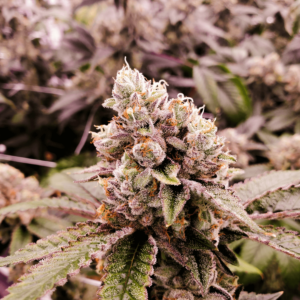
The Flowering Cycle: From Vegetative to Budding Stage
The flowering cycle is one of the most critical phases in cannabis cultivation. Understanding how the plant transitions from the vegetative phase to the flowering phase can help growers optimize their yields and produce high-quality buds.
Vegetative vs. Flowering Stage
- Vegetative Stage: During this stage, the plant focuses on root and leaf growth. This phase is crucial for developing a strong plant structure.
- Flowering Stage: This is when the plant shifts its energy to produce flowers and buds. The plant’s energy is directed toward bud development, and cannabinoids are produced.
Conclusion: The Importance of Understanding Cannabis Plant Anatomy
In conclusion, the anatomy of the cannabis plant is complex but essential for understanding its growth, health, and the quality of the products it produces. Whether you’re growing cannabis or simply consuming it, knowing how each part of the plant contributes to its overall function will give you a deeper appreciation for this remarkable species.
As cannabis continues to gain popularity and is studied more extensively, understanding its anatomy will only become more important. Whether you’re cultivating it or using it medicinally, the better you understand how the plant works, the more you’ll benefit from its full potential.
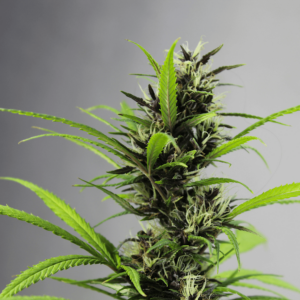
Frequently Asked Questions
1. What are the main parts of the cannabis plant?
The cannabis plant consists of several key parts, each with its own function:
- Roots: Anchor the plant and absorb water and nutrients.
- Stem: Provides structure and transports nutrients and water.
- Leaves: Perform photosynthesis, converting light into energy.
- Flowers: The reproductive organs, where cannabinoids and terpenes are produced.
- Trichomes: Tiny, glandular structures on the flowers and leaves that produce THC, CBD, and terpenes.
Understanding the role of each part helps in cultivating healthy plants and producing potent cannabis.
2. How do trichomes affect the quality of cannabis?
Trichomes are essential for producing the plant’s most valuable compounds, including THC, CBD, and terpenes. These tiny resin glands give cannabis its characteristic aroma and are the primary source of the plant’s psychoactive and medicinal effects. A higher concentration of trichomes typically means more potent buds, making them a key factor in determining cannabis quality.
3. What is the difference between male and female cannabis flowers?
Male and female cannabis plants have distinct roles in reproduction:
- Male Flowers: Produce pollen but do not create buds. They are typically removed in cultivation to prevent fertilization.
- Female Flowers: These are the plants that produce the buds we consume. Female flowers contain the resin-rich trichomes that house cannabinoids and terpenes. Female plants are prized for their flower production, as they are the source of most cannabis products.
4. Why are the roots of the cannabis plant so important?
The roots are critical for the overall health of the cannabis plant. They anchor the plant in the soil and are responsible for absorbing water and nutrients. A healthy root system allows the plant to grow strong and support large, resinous buds. Proper care of the root system (e.g., ensuring good drainage and avoiding overwatering) is essential for successful cultivation.
5. How do I identify the cannabis species based on its anatomy?
The three main cannabis species—Cannabis sativa, Cannabis indica, and Cannabis ruderalis—can be identified through their anatomy:
- Cannabis sativa: Tall, slender plants with narrow leaves. Known for uplifting, energetic effects.
- Cannabis indica: Shorter, bushier plants with broad leaves. Often associated with relaxing, sedative effects.
- Cannabis ruderalis: Smaller plants that flower automatically (autoflowering). Often used in hybrid breeding.
Each species has different growth patterns and leaf structures, so identifying these traits can help distinguish them.





